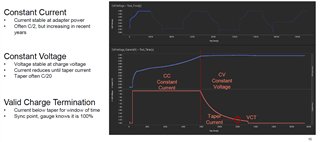Other Parts Discussed in Thread: BQ25606
we are using bq27441 in our products. we are planning to use a new li-ion battery with a protection circuit attached to it. We are aware that the chem Id cannot be changed and it’s 128.
However when we acquired V, I and T values and send the results to gpc, we found that Dod is 35% and therefore not suitable.
We have questions regarding the test we did and its results:
1- does the protection circuit attached to it affect the results? Should we do the test without the protection circuit? for me I believe we should do the test with the protection since we are going to use it but I need your confirmation in this point.
2- if we go forward and do the learning cycle, what are the consequences of using high Dod error? the battery in the product will be connected all the time. I understand that when the battery is reconnected, it will not give the accurate soc, but if we charge and discharge the product, the gauge will be soc with good enough accuracy? or other issues will be apparent later? Like soc jumps or anything else?
3- does the charging speed affect the gpc results? or it’s not relevant.
4- we are interested in using in the future TI GDK kit to acquire the data for gpc. Can we still use it as well to acquire the learning cycle after programming the gauge with chem Id 128 and the charger charging current with what we use in our product? Is this a good idea or we should use just for gpc and use bq27441 and the same charger we use in our products?
Thank you for assistance. We need to take the decision to use the new battery or not.


